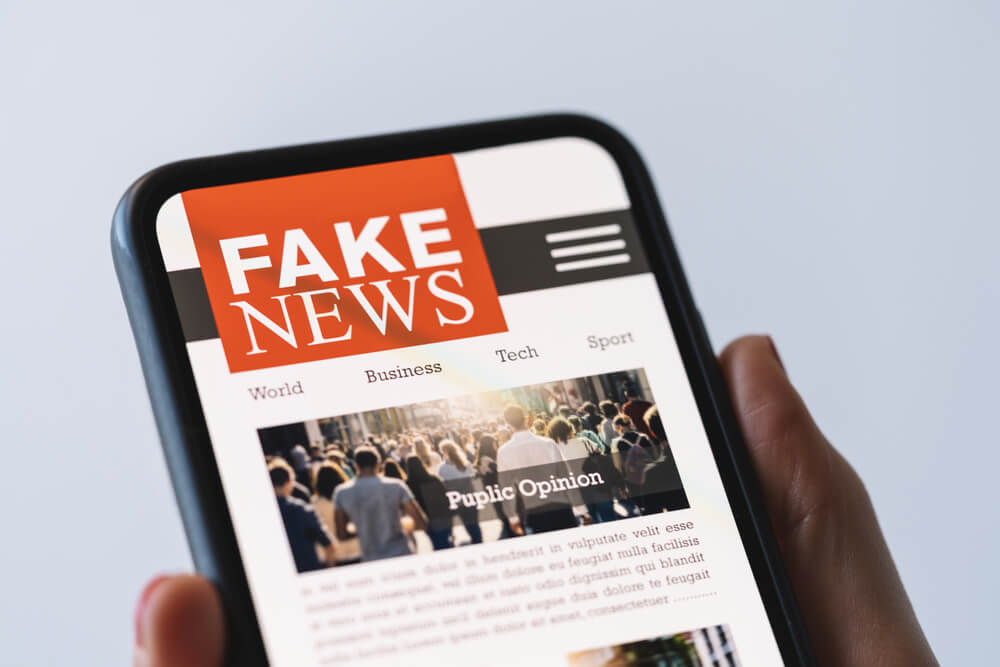Misinformation: Best Examples of Fake News to Help You Stay Vigilant

We are living in a world where information is abundant. But sadly, this has also led to a rise in misinformation or fake news. With social media being a primary source of news for many, it’s becoming increasingly challenging to distinguish between real and fake news.
As a result, staying vigilant is more crucial than ever.
In this blog post, we’ll take a closer look at some of the best examples of fake news to help you stay informed and protect yourself (and your family) from misinformation.
Contents:
- What is Misinformation, Disinformation, and Fake News?
- How to Identify Fake News
- Examples of Fake News for Students in Social Media
- List of Fake News Websites
What is Misinformation, Disinformation, and Fake News?

pikselstock/Shutterstock.com
In today’s era of digitalization and social media, misinformation/disinformation and fake news have become a rampant problem worldwide. It has created chaos, panic, and fear-mongering amongst people, which has adversely affected their thoughts and decisions.
Misinformation refers to false or inaccurate information shared without the intent to deceive. It is not created with the intention to harm or deceive at a societal level. Disinformation, on the other hand, involves deliberately spreading false information to manipulate or mislead people. Fake news encompasses both misinformation and disinformation, often involving fabricated stories presented as factual news.
Misinformation can be corrected by providing correct information based on facts. Sometimes, unintentional misinformation can also be innocuous, while fake news can lead to dangerous consequences.
As a parent, it is your responsibility to safeguard your family, and understanding the difference between misinformation and fake news can help you to act judiciously.
Let’s break things down a bit more.
Types of Fake News

Egoitz Bengoetxea/Shutterstock.com
Here are some of the most common types of fake news you might encounter:
- Sensational news: This type of news is highly exaggerated to gain attention and generate TRP. It plays with people’s emotions, creating a sense of drama and urgency, without providing any concrete evidence or facts.
- Clickbait news: As the name suggests, clickbait news is designed in such a way that it attracts readers to click on the article. The sole intention behind such news is to generate more clicks and ad revenue.
- Satirical news: This type of news has a humorous or sarcastic tone, but the underlying intention of such news is often misunderstood, leading to misinformation or disinformation.
- Out-of-context news: This type of news is created by taking quotes, videos, or images out of their original context, thus owing to twisted or manipulated facts.
Where Does Fake News Come From—and Why?

PeopleImages.com – Yuri A/Shutterstock.com
Fake news is not a new phenomenon. It’s been around for centuries, but the advent of the internet and social media have given it new dimensions. Anyone with a computer can create fake news without any regulations.
The reasons for creating fake news could vary. Some create it for fun, while others do it for spreading propaganda or achieving political gain. Fake news could have a severe impact on society, especially when it comes to politics, health, and social issues.
The internet possesses vast amounts of information, and it can be tough to separate facts from fiction. Social media platforms like Facebook and Twitter have made it easy for fake news to spread because most of the articles are not verified or mediated. Moreover, people tend to share news without proper fact-checking. Therefore, it’s essential to verify the facts and sources of the news before sharing.
Fake news does not always stem from unknown sources. Sometimes, news outlets also tend to twist the facts to make a sensational story. Some news channels propagate fake news to fulfill their political motives or cater to their specific audience. Therefore, you should only trust news sources that have a good track record and not fall for sensational headlines.
Fake news could have disastrous consequences. For instance, during the COVID-19 pandemic, many people believed misinformation, causing widespread panic. Similarly, during the recent US election, many false stories circulated, leading to political unrest and conflict.
Always take news from any medium with a grain of salt and try not to get swayed away by the emotion it evokes.
How Does Fake News Work?

r.classen/Shutterstock.com
Fake news works by taking advantage of our cognitive biases, including confirmation bias, which means we are likely to believe the information that confirms our existing beliefs or opinions and tend to ignore things that contradict our views.
The creators of fake news use this bias to their advantage. They craft a piece of news that aligns with people’s pre-existing biases, making the piece seem more believable. A lot of fake news articles will contain information that is slightly incorrect or skewed to make the story more interesting.
Fake news spreads like wildfire on social media platforms, mainly because people are more likely to share news that they consider ‘shocking,’ ‘outrageous,’ or very ‘entertaining.’ People share fake news stories, even if they don’t entirely believe them, to maintain their social status by presenting themselves as someone who is in on the latest news or trends.
Fake news spreads extremely fast because of the social confirmation bias—people tend to trust news that they see their friends or family sharing.
How Do Fake News and Misinformation Impact Children and Young People?

DimaBerlin/Shutterstock.com
When children are exposed to fake news and misinformation on the internet, it can start to shape their views of the world. For example, if a child comes across an article that falsely claims that immigrants are all criminals, it can create a bias in the child’s mind that sticks with them for years to come.
Not only that but when children are exposed to misinformation, it can cause them to feel anxious and stressed. For example, if a child reads a fake newspaper about a natural disaster happening in their local area, they may become stressed and worried, even though the disaster is not happening. This can lead to anxiety and stress that can have lasting effects on their mental health.
Finally, when children are exposed to false information, it can be hard for them to distinguish between what is true and what is not. This can lead to a lack of critical thinking skills and an inability to make sound, informed decisions in the future.
How to Identify Fake News

Song_about_summer/Shutterstock.com
- The first step in identifying fake news is to verify the source. Take time to evaluate the source of the articles or newspapers. If it’s from a well-known and trustworthy source, chances are, it is a credible story.
- If the source is unknown, is a satirical website, or has a clickbait headline, then it is likely the story has been faked.
- A rule of thumb is always to check the domain name to ensure the website is legitimate.
- Investigate the author’s qualifications and expertise. Fake news often lacks proper attribution.
- A trustworthy news outlet will provide verifiable evidence to back up its claims. Always look for data or quotes from experts and sources and check that they are reliable. If an article provides only vague explanations and no supporting evidence, then it is likely fake news.
- Fake news might use manipulated visuals. Use reverse image searches to verify authenticity.
- Also, check the tone of the article—real news should be written in an unbiased and informative manner, while fake news often uses heightened language and emotional appeals.
- Fake news can often circulate under the guise of current news when, in fact, it is outdated. Always check the date of the article to ensure it is relevant to current events.
- Additionally, sometimes fake news stories will resurface periodically, so if a news item seems familiar, it may be worthwhile to revisit its source and check if it is still accurate.
- Cross-check with other sources. If numerous trustworthy news outlets are reporting the same story, it is likely true. However, if only one or two less well-known sources are reporting a news story that sounds doubtful, it’s best to cross-reference with other sources. The confusion and contradiction between various sources should be taken as an indication that the supposed news may be faking it.
Take care of both your child’s mental and physical well-being. Install the Findmykids app with geo-tracking and sound-around features on their phone to always know where your child is and what they are doing!
Examples of Fake News for Students in Social Media

MAD.vertise/Shuttertock
In today’s digital age, social media is an essential part of our lives. With social media platforms like Twitter, Facebook, Instagram, and TikTok, we can stay connected with the world and share our thoughts and ideas instantly.
However, the information posted on social media is not always accurate and reliable. There are numerous cases of fake news that can spread like wildfire and gain traction in no time. Fake news can be harmful and can cause chaos and confusion among people, especially students, who are easily influenced by what they see on the internet.
Here are some examples of fakes that students should be aware of when using social media.
Celebrities Death Hoaxes
Fake news about celebrity deaths is a rampant problem on social media. Students should be wary of such news and double-check the source before believing in and sharing it.
For instance, recently, fake news about rapper Lil Wayne’s death went viral, causing chaos on the internet. However, the news was soon debunked, and Lil Wayne was found to be alive and well.
Political Propaganda
Political propaganda is a major problem on social media. Fake news and misinformation are used to spread propaganda and sway people’s opinions. Students should be cautious and verify the source of the news and check if it’s a credible one or not.
For instance, during the 2016 US presidential election, there were cases of fake news circulating on social media that influenced people’s opinions and affected the election results.
Photoshop Manipulated Images

FGC/Shutterstock.com
Photoshop has made it easy to manipulate images, and fake images are a common occurrence on social media. Students should be aware of such manipulated images and be careful before sharing them.
For example, an image of a shark swimming on a flooded highway during Hurricane Harvey went viral on social media. It turned out to be a Photoshop manipulation, and the real image showed a man standing on the highway.
Fake Reviews
Online reviews have a significant impact on businesses and their reputations. However, fake reviews are a prevalent problem on social media. Students should be cautious and double-check any reviews that they come across on social media before making any decisions based on them.
For example, fake hotel reviews created by bots to improve their ratings have been reported, and students should be aware of such reviews to make informed decisions.
List of Fake News Websites

fizkes/Shutterstock.com
Fake news is everywhere these days, and it’s not always easy to tell what’s real and what’s not. It can be on any site, but here are some of the most common fake news websites to be aware of:
- The Onion. This one shouldn’t be a surprise to anyone. The Onion is well-known for its satirical content. While it’s never meant to be taken seriously, sometimes people miss the joke and share articles as if they’re real news. So, while The Onion might not be intentionally trying to deceive anyone, it’s still worth noting that their articles are not to be taken seriously.
- Infowars. Infowars is a notorious fake news website that has been responsible for spreading all sorts of conspiracy theories and misinformation. They’re known for their right-wing political views and often peddle fear-mongering and sensationalism. It’s best to avoid this website entirely if you’re looking for accurate news.
- NewsPunch. NewsPunch is another fake news website that is infamous for its sensationalist headlines and misleading content. They often report on conspiracy theories and outlandish claims, without any evidence to back them up. It’s best to stay away from this website if you’re looking for real news.
- Daily Mail. While the Daily Mail is technically a real news website, they are infamous for their clickbait headlines and sensationalist reporting. They often exaggerate and distort the truth in order to get more clicks. While they do occasionally report on real news, it’s best to take everything they say with a grain of salt.
- Natural News. Natural News is a website that claims to be all about natural health and wellness, but in reality, they’re known for spreading dangerous misinformation about vaccines and drugs. They often promote pseudoscientific claims without any evidence to back them up. It’s important to stay away from this website if you’re looking for accurate information on health and wellness.
The spread of fake news is a growing concern—and it’s so important to stay vigilant online.
By educating yourself and verifying sources before sharing information, you can help stop the spread of false information. Don’t believe everything you read online—and always take your time to research and scrutinize stories.
As a parent, teach your children to stay vigilant and seek reputable sources, not to believe everything they see or hear online, and to build a mindset of critical thinking that will allow them to better interpret the news they see and hear.
Stay vigilant—and stay safe!
The picture on the front page: Shyntartanya/Shutterstock.com
Проверьте электронный ящик



















